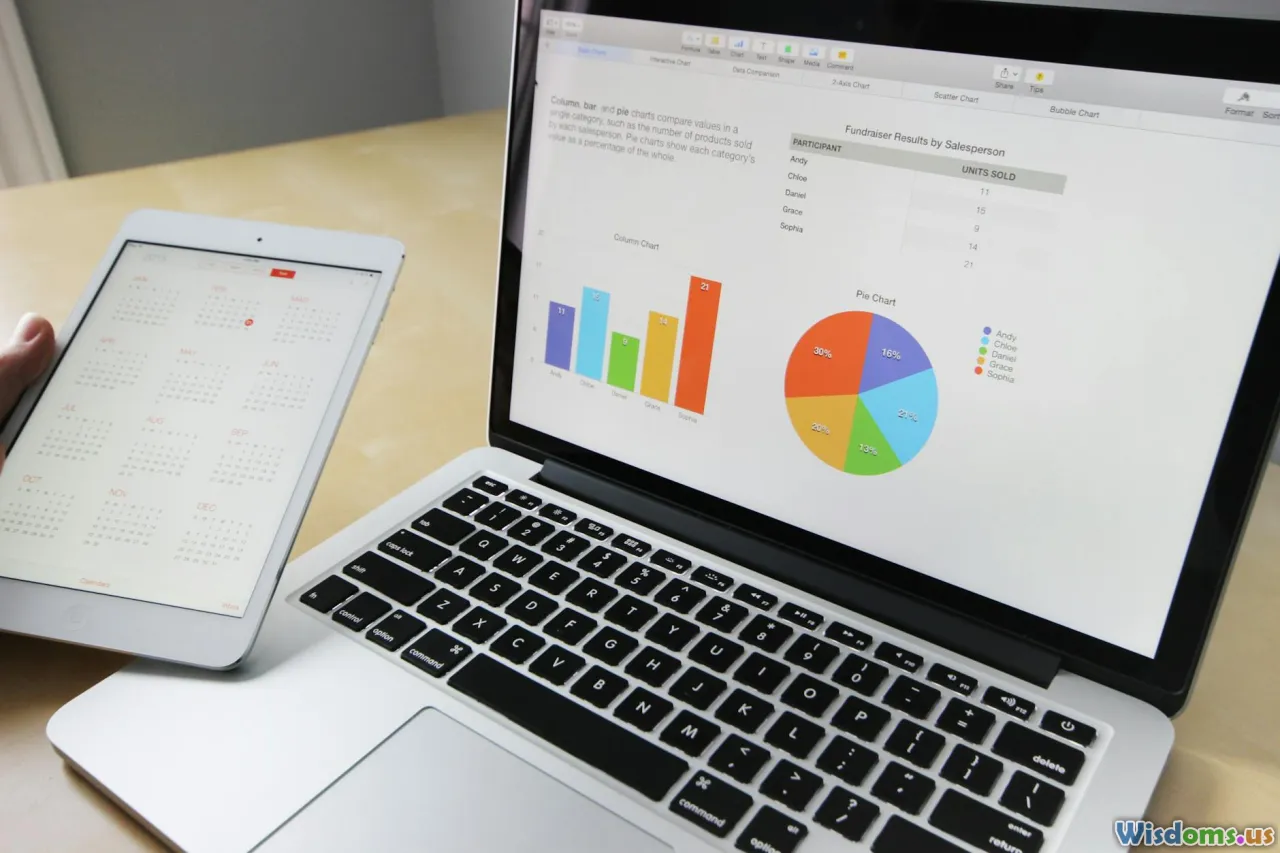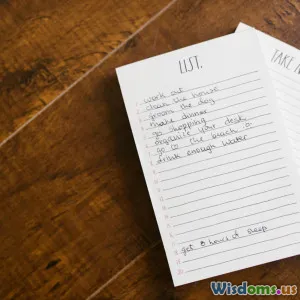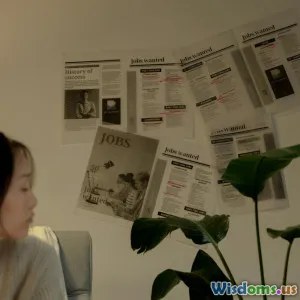
Three Tiny Habits That Dramatically Boost Productivity
12 min read Discover three simple yet powerful habits to skyrocket your daily productivity and stay focused, energized, and consistently ahead in your work. (0 Reviews)
Three Tiny Habits That Dramatically Boost Productivity
Imagine if you could get more done every day—without burning out, constantly Googling the latest hacks, or revamping your schedule overnight. Productivity isn’t just about grand gestures or radical changes; it’s increasingly driven by micro-actions that ingrained as habits have transformative effects. Here’s a deep dive into three supremely small but powerful habits that are proven, backed by real-life examples and research, to elevate personal productivity. These are habits you can start implementing today—each one requiring a minimal upfront investment, but accumulating extraordinary long-term results.
Habit 1: The Two-Minute Tidy

How a Brief Cleanup Sparks Major Mental Clarity
A messy workspace is more than just an eyesore—it’s a mental weight. Research published in the Journal of Neuroscience found that visual clutter competes for your brain’s attention, leading to decreased focus and increased cognitive overload.
How to Implement the Two-Minute Tidy
Swap marathon cleaning sessions for a simple, repeatable ritual: take two minutes at the start or end of your day to organize your desk, close stray browser tabs, or clear off digital clutter. Here’s a practical breakdown:
- Physical: Toss out empty coffee cups, align your notebook and pens, put files in dedicated drawers.
- Digital: Close unrelated programs, archive finished emails, move documents into appropriate folders.
Set a phone timer for two minutes—don’t overthink, just act! Consistency is the secret: repeated daily, this habit sticks and gradually creates a perpetually clean environment.
Real-World Example
Consider Sarah, an accountant who found herself increasingly frazzled as tax season approached. By using a two-minute tidy at the beginning and end of her day, she was able to keep her workspace from devolving into paper chaos. "That two-minute window sandwiches my day—I'm not hunting for lost files and I open my computer with a clear mind," she says.
Why It Works
- Reduces decision fatigue: You're not wasting mental energy on the same cleanup decisions later.
- Preps your mind for work or rest: Bookending your day gives closure, signaling switching off.
- Creates positive momentum: Completing a tiny task gets you into an action-oriented mindset.
Habitual, tiny tidies ripple into hours of regained focus over weeks and months.
Habit 2: The Five-Minute Mapping

How Mini Planning Bypasses Overwhelm and Ignites Purposeful Action
Most of us tend to overestimate our daily capacity or fall into the trap of confusing activity with productivity. Successful, highly-able professionals—CEOs, authors, project managers—credit their effectiveness to a bias for quick, upfront planning.
Steps to Put Five-Minute Mapping to Work
Dedicate five minutes—before you jump into emails, meetings, or endless scrolling—to jot down the top three tasks for the upcoming block (morning, afternoon, or whole day). Instead of building out an elaborate planner or productivity framework, this can happen on:
- A post-it note bedside table
- A notebook margin
- The digital notes app you already check
Break each task into the tiniest actionable units (e.g., instead of "Prepare report," write "Pull last quarter numbers").
Science Behind Daily Micro-Planning
A Harvard Business School study strongly associates brief daily planning with job satisfaction and measurable output. People who allocate just five minutes to plan are nearly 30% more likely to complete their priority items than those who wing it.
Insight: Why Does It Work So Well?
- Reduces cognitive load: Your brain doesn’t have to work in overdrive trying to recall what’s important.
- Reinforces intentionality: You proactively decide what's impactful rather than reactively fighting fires.
- Builds a feedback loop: Seeing key tasks checked off, even if small, motivates ongoing effort.
Real-Life Case: The Morning Stack
Jacob, a creative director long allergic to planners, started a five-minute mapping habit using sticky notes. Every workday upon opening his laptop, he scribbles down three core goals, estimates how long they’ll take, and leaves the sticky at his keyboard. This bite-sized structure helped him cut unrelated meetings, focusing on deep, meaningful work. "Some days, all I do is finish those three tasks. But by month's end, the progress is night and day," he observes.
Habit 3: Tactical Task Switching

How Purposeful Shifting, Not Multitasking, Unlocks Efficient Flow
We’re bombarded with calls, notifications, and competing tasks, making multitasking tempting—but scientifically, true multitasking destroys productivity. However, tactical switching—deliberately shifting tasks under pre-set rules—can safeguard energy while improving end results.
Setting Up Tactical Task Switching
Implement fixed windows (e.g., 30 or 60 minutes) where you focus exclusively on a single task—then intentionally switch to a distinctly different kind of activity. Use the Pomodoro Technique (25 min work, 5 min rest), or simply set a recurring timer.
For example:
- 9:00–9:30 am: Write proposal draft
- 9:30–9:35 am: Take a short walk or respond to basic emails
- 9:35–10:05 am: Analyze data set
This rhythm creates clear blocks for deep work and strategic breaks, aligning with how human attention operates best—in bursts, followed by recovery.
The Power of Deliberate Transitions
Deliberate task switching supports the brain's need for change without falling into the multitasking trap (where cognitive performance and memory plummet by up to 40%, according to a Stanford study).
Real-World Example: Priya, a remote marketer juggling five brands, adopted tactical task switching after noticing she lost steam by midday. Her process:
- Sets a 50-minute work timer with a 10-minute break
- During breaks: stands/stretch, water refill, quick text catch-up
- Returns to different task category for the next block
She reports sharper creativity and less fatigue, noting, "Instead of spinning my wheels all day, I'm sprinting, resting, then switching. The difference by 3 pm is massive."
How to Avoid Common Mistakes
- Don’t double-task (e.g., answering emails during meetings)—full focus on one activity per block.
- Be strict with transitions: Set alarms or visual cues to remind yourself to switch.
- Mix high and low-energy tasks: Don’t sequentially stack draining work; vary for sustained alertness.
Small, timed shifts are the antidote to both dullness and overwhelm.
Making Tiny Habits Stick for the Long Haul
Why Do Most Tiny Habits Fail? It’s Often Friction, Not Motivation.
It’s easy to read about new productivity rituals but forget them in the crush of everyday demands. Behavioral scientists like BJ Fogg assert that habits stick best when they are simple, immediately rewarding, and tied to existing routines.
Practical Ways to Ensure Consistency
- Habit Stack: Attach each mini-habit to a longstanding ritual (do two-minute tidy right after coffee; plan three tasks just before morning emails; switch tasks when a daily meeting ends).
- Track for 7–14 days: Use an ultra-basic habit tracker (paper calendar or free app). Checkmarks or visual streaks create rewarding feedback.
- Set micro-celebrations: Acknowledge completing each habit, even quietly (a stretch, a favorite song, or a short appreciation).
Habit Failure as Opportunity
Expect occasional lapses. The magic is in the next repetition, not perfection. Noted productivity author James Clear writes, "Never miss twice." If a day goes sideways, focus on getting the habit back the next time—without self-recrimination.
Designing Your Personal Productivity Ecosystem

True, sustained productivity is an environment—an ecosystem—that flourishes when nurtured by tiny, mutually-reinforcing habits.
Examples of Systemizing the Three Habits
- Workspace: Place a small basket or box within arm’s reach, so tidying is physically easy; set your desktop homepage to a single clean dashboard.
- Planning: Use color-coded sticky notes or digital project boards (Trello, Notion’s daily cards) to visually reinforce your three tasks.
- Task Switching: Android/iOS shortcuts or apps like Focus Keeper help automate timers; visual cues (colored lights or desk icons) signal when to switch modes.
Compound Gains Over Time
Just as dropping a single coin into a jar adds up to wealth, these easy, two-to-five-minute actions yield exponential returns by preventing distraction, steering attention, and maximizing purpose. They form autopilot routines—unburdening your willpower for the work that really matters.
More Than Just Hustle: Tiny Habits, Lasting Results
In a culture obsessed with relentless hustle, we overlook the transformative capacity of repeated, subtle cues that gradually rewire our workdays for clarity and momentum. By anchoring your ask for improved productivity in tiny habits—the two-minute tidy, five-minute mapping, and tactical task switching—you reclaim hours, banish scattered stress, and progress meaningfully in both work and life. The secret is not in massive overhauls, but in small, repeatable wins serving as a foundation for much bigger accomplishments to come.
Rate the Post
User Reviews
Popular Posts



















